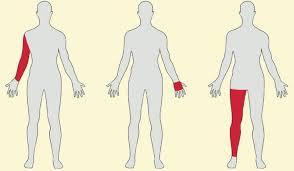Call or email us. It’s completely confidential.
Speak to a lawyer about your situation for free.
We give you advice and/or a lawyer referral.
Explaining Man As A Whole?
Since 2001 we have helped tens of thousands of injured Illinois workers. Contact us at 312-346-5320 for help everywhere in Illinois. You will speak with a lawyer for free to ask questions or get an attorney referral.
 Illinois workers’ compensation law can be complex. One area with unfamiliar legal jargon (for most clients) regards settlement calculations and the phrase “man as a whole.”
Illinois workers’ compensation law can be complex. One area with unfamiliar legal jargon (for most clients) regards settlement calculations and the phrase “man as a whole.”
A settlement in a workers’ compensation case is based on a percentage of loss of use for a specific body part. Even if you make a complete recovery, the Arbitrator decides how much loss you initially suffered due to the work injury.
For example, if you injure your knee, your settlement is calculated based on a percentage of loss to the leg. A wrist injury is classified as a loss of the hand, while an elbow injury is considered a loss of the arm.
Each body part has a designated value—such as a leg being worth 215 weeks of benefits. If a leg amputation occurs, the injured worker receives 215 weeks of compensation. However, if surgery is performed and an Arbitrator determines there is a 40% loss of the leg, the worker would receive 86 weeks of benefits, regardless of their ability to walk. It’s essentially a myth because the higher percentage mostly relates to how serious your injury was, not how disabled you currently are. You can make a complete recovery and still get a high percentage for your settlement.
Certain body parts, including the back, neck, shoulder, and head, do not have specific loss of use classifications. Instead, they are grouped under the category of “man as a whole.” This means that a work-related back fusion or concussion falls into the same classification, despite affecting different areas of the body. Injuries classified as “man as a whole” are generally the most valuable in Illinois workers’ compensation cases, as they are based on a 500-week benefit scale.
What Clients Are Saying
"Highly recommend"
I was skeptical, but the attorney you recommended was so nice and was everything you said he’d be and more. Thank you so much. I would recommend this site to anyone.
"They were great"
The workers’ compensation law firm you referred my friend to has been great. They really stopped jerking him around once he hired the attorney you suggested.
A 100% loss under this classification is practically impossible. If a worker were to suffer a fatal injury, benefits would cease, and if a back or neck injury were severe enough, the individual would likely qualify for permanent disability compensation. However, serious injuries can still result in a substantial settlement. For instance, receiving 43% loss of the “man as a whole” would yield the same benefits as losing a leg entirely. (500 x .43 = 215)
Prior settlements work differently for an arm or leg case versus a “man as a whole” case. If a worker settled a case in 2022 for a 15% loss of the leg and then suffered another leg injury in 2025 that would typically warrant a 25% loss settlement, the insurance company would only be responsible for the remaining 10%, as they receive credit for the prior settlement.
However, “man as a whole” cases work differently—prior settlements do not reduce future awards. This means a worker could receive compensation for a 45% loss in 2015, another 40% in 2022, and an additional 40% in 2025 (totaling 125%) and still receive full benefits each time. Because of this, an experienced attorney will aim to classify a settlement under “man as a whole” whenever possible.
These classifications matter because injuries affecting the back, neck, shoulder, or head can impact the overall function of the body. While this system may not be intuitive, it’s important for injured workers to understand their rights and not make decisions that could hurt them in the future. If you’d like to discuss your case, our team offers free consultations. We help injured workers throughout Illinois and are available via phone or email at any time.
